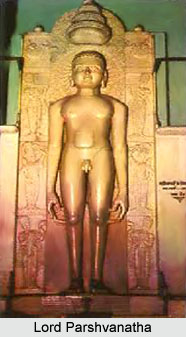 Shri Reshandigiri Teerth located in Madhya Pradesh is a Jain pilgrimage centre. Te teerth kshetra is located on a small high hill near the Resandigiri village. The temple is dedicated to Lord Parshvanatha, the twenty-fourth Jain Tirthankara.
Shri Reshandigiri Teerth located in Madhya Pradesh is a Jain pilgrimage centre. Te teerth kshetra is located on a small high hill near the Resandigiri village. The temple is dedicated to Lord Parshvanatha, the twenty-fourth Jain Tirthankara.
History of Shri Reshandigiri Teerth
According to history Shri Reshandigiri Teerth dates back to the ancient times. As per reference a Shravak had dreamt about the temple and then traced its location. The temple is known as Parshvanatha temple. This teerth khetra is believed to belong to the times of Lord Parshvanatha. It is said that this place has been the Samavasaran of Lord Parshvanatha. A river can be seen in the vicinity of the temple. A slab can be seen in the centre of the river which is known as Siddhashila. Muni Varadatt practised penance on it and attained his liberation. The idol of Lord Parshvanatha is believed to possess miraculous powers. Devotees from far off places visit the temple to offer their prayers. It is believed that if prayed with all devotion the Lord fulfils the wishes of the pilgrims.
Temple of Shri Reshandigiri Teerth
The temple of Shri Reshandigiri Teerth houses the idol of Lord Parshvanatha. The temple has been magnificently decorated with intricate artistic designs. The creative temple work boast about the skills of the craftsmen. The idol of the temple is almost 335 cm in height and is almond coloured. It can be seen in Khadgasana posture. The idol has been beautifully carved from a single stone and looks very appealing. The smiling face of the Lord looks very calm and serene. Apart from this there are 35 other temples on the hill that have been attractively constructed. Other than these there are 15 temples at the foot of the hill. Amongst these one temple is in the midst of water and is known as Jalmandir. All these temples are worth visiting and stand as finest specimens of artistic workmanship. Many other idols of Munindradatt, Indradatt Vardatt, Gundatt and Sagardsatt have been unearthed from the ground and have been installed in the temple. These idols can be seen sitting in the samvasarana.
The Temple of Shri Reshandigiri Teerth organises many annual gatherings and functions. A fair is held here from the tenth day to the fifteenth day of the dark half of the month of Magasar. There are provisions for dharamshalas or rest houses for the pilgrims. These are well equipped with all modern facilities. Apart from this there are Upashrays and Ayambilshala here. The temple is enclosed by scenic beauty that mesmerizes and fascinates the pilgrims. Thus the calm and tranquil environment and the surrounding greenery make it a suitable place for religious activities. The kshetra is well connected to road, rail and air. Taxi services and bus services are easily available here. The nearest railway station of Sagar is at a distance of 56 kilometers and Shahgadh, the nearest village is at a distance of 13 kilometers from this teerth.




















